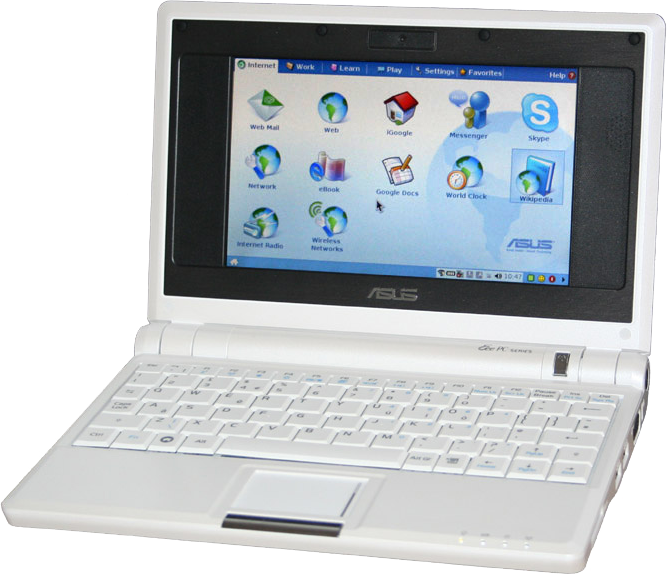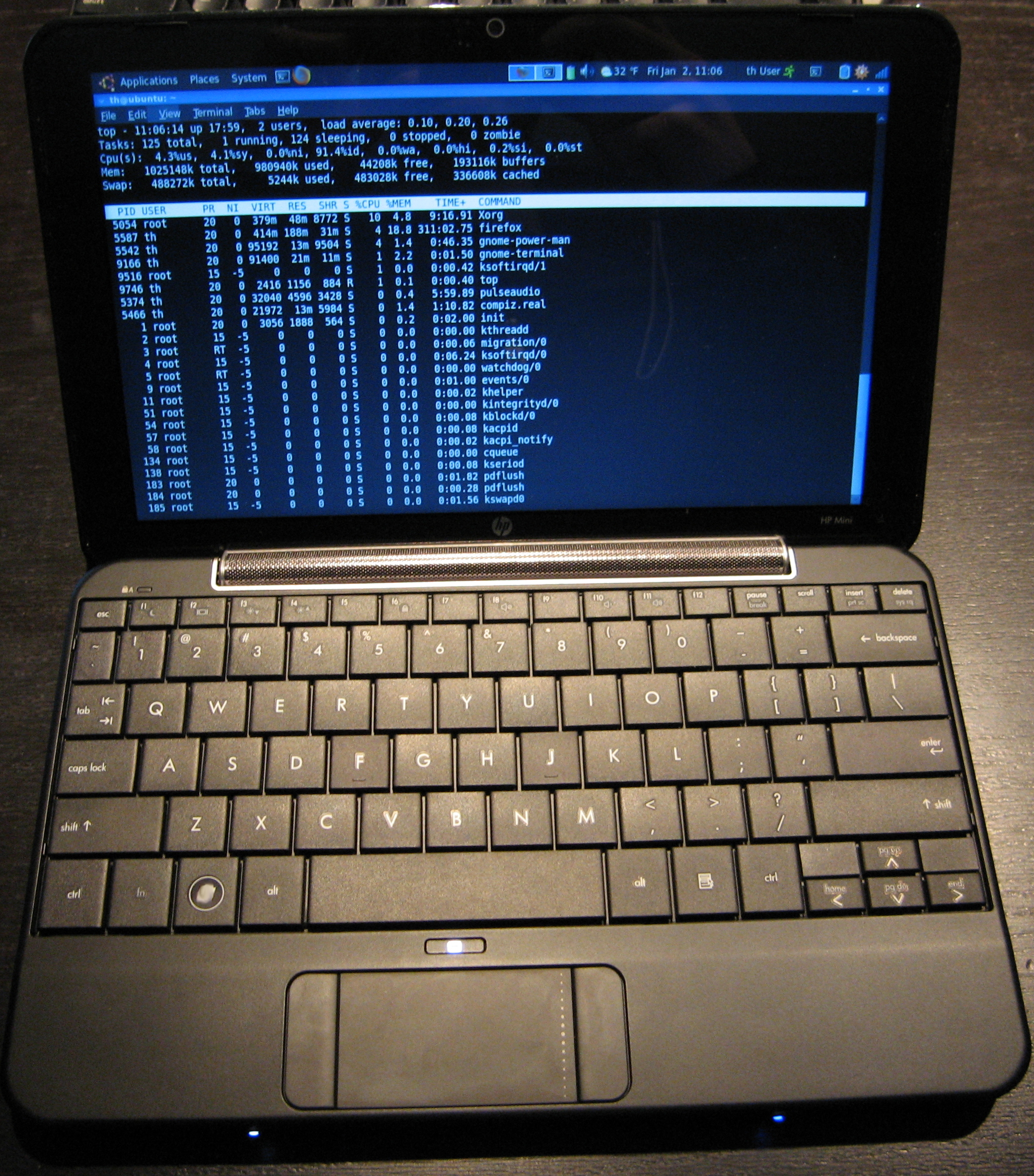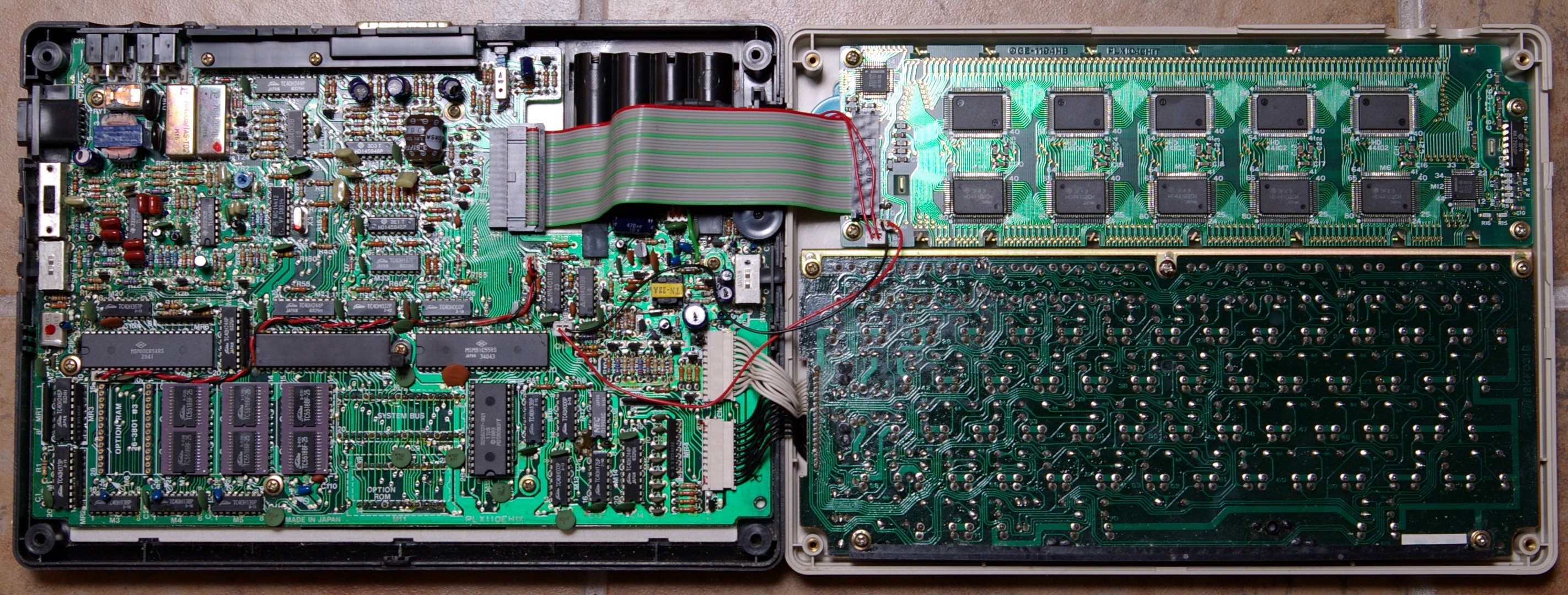|
Subnotebook
Subnotebook, also called ultraportable, superportable, or mini notebook, was a marketing term for laptop computers that are smaller and lighter than a typical notebook-sized laptop. Types and sizes As typical laptop sizes have decreased over the course of the 2010s, and other distinguishing features have become mainstream, the distinction between regular-size and 'subnotebook' laptops has largely disappeared. To the extent that it still exists, 'subnotebook' could be defined as machines with screen smaller than 13" but with a permanently-attached keyboard intended for two-handed typing. Prior to this convergence, subnotebooks were also distinguished from netbooks and ultra-mobile PCs, based on both size and market position. Classic subnotebooks were smaller than full sized laptops but larger than handheld computers. They were distinguished by smaller screens and bodies and lighter weights relative to contemporaneous laptops. The savings in size and weight were often achieved ... [...More Info...] [...Related Items...] OR: [Wikipedia] [Google] [Baidu] |
Ultra-mobile PC
An ultra-mobile PC, or ultra-mobile personal computer (UMPC), is a miniature version of a pen computer, a class of laptop whose specifications were launched by Microsoft and Intel in spring 2006. Sony had already made a first attempt in this direction in 2004 with its Vaio U series, which was only sold in Asia. UMPCs are generally smaller than subnotebooks, have a TFT display measuring (diagonally) about , are operated like tablet PCs using a touchscreen or a stylus, and can also have a physical keyboard. There is no clear boundary between subnotebooks and ultra-mobile PCs, but UMPCs commonly have Major factors other than the common clamshell laptop design, such as having small keys on either side of the screen, or having a slide-out keyboard. The first-generation UMPCs were simple PCs running Linux or an adapted version of Microsoft's tablet PC operating system. With the announcement of the UMPC, Microsoft dropped the licensing requirement that tablet PCs must support prox ... [...More Info...] [...Related Items...] OR: [Wikipedia] [Google] [Baidu] |
Smartbook
A smartbook was a class of mobile device that combined certain features of both a smartphone and netbook computer, produced between 2009 and 2010. Smartbooks were advertised with features such as always on, all-day battery life, 3G, or Wi-Fi connectivity and GPS (all typically found in smartphones) in a laptop or tablet-style body with a screen size of 5 to 10 inches and a physical or soft touchscreen keyboard. A German company sold laptops under the brand ''Smartbook'' and held a trademark for the word in many countries (not including some big markets like United States, China, Japan, or India). It acted to preempt others from using the term ''smartbook'' to describe their products. Smartbooks tended to be designed more for entertainment purposes than for productivity and typically targeted to work with online applications. They were projected to be sold subsidized through mobile network operators, like mobile phones, along with a wireless data plan. The advent of much mor ... [...More Info...] [...Related Items...] OR: [Wikipedia] [Google] [Baidu] |
Eee PC
The ASUS Eee PC is a netbook computer line from Asus, and a part of the ASUS Eee product family. At the time of its introduction in late 2007, it was noted for its combination of a lightweight, Linux-based operating system, solid-state drive (SSD), and relatively low cost. Newer models added the options of Microsoft Windows operating system and rotating media hard disk drives (HDD), and initially retailed for up to 500 euros. The first Eee PC was a milestone in the personal computer business, launching the netbook category of small, low-cost laptops in the West (in Japan, subnotebooks had long been a staple in computing). According to Asus, the name Eee derives from "the three Es", an abbreviation of its advertising slogan for the device: "Easy to learn, Easy to work, Easy to play". In January 2013, ASUS officially ended production of their Eee PC series, citing declining sales due to consumers favoring tablets and Ultrabooks over netbooks. However, they subsequently restarted ... [...More Info...] [...Related Items...] OR: [Wikipedia] [Google] [Baidu] |
Netbook
Netbook was a commonly used term that identified a product class of small and inexpensive laptops which were sold from 2007 to around 2013. These machines were designed primarily as cost-effective tools for consumers to access the Internet from any location before the widespread advent of smartphones, and as a result, generally had lower-end hardware specifications than consumer laptops of the time, being primarily intended as clients for Internet services. While ''netbook'' has fallen out of use, these machines evolved into other products including Google's Chromebook, and mobile devices, particularly tablet computers, often running mobile operating systems such as iOS or Android. At their inception in late 2007, as smaller-than-typical laptop computers optimized for low weight and low cost, netbooks began appearing without certain then-standard laptop features (such as an optical drive), and with less computing power than in full-sized laptops. Later netbooks ... [...More Info...] [...Related Items...] OR: [Wikipedia] [Google] [Baidu] |
Sony VAIO C1
The Vaio C1 PictureBook was a series of subnotebooks from Sony's Vaio lineup, branded 'PictureBook' for its webcam and video capture capabilities, a first for portable computers. PictureBooks were lightweight computers, weighing 1kg (2.2 lb). They featured 8.9" LCD displays, and were notable for being the first consumer laptop with a built-in webcam. The original model, the PCG-C1, was first released on September 19, 1998, in Japan only, with an initial production run of 5,000 units. Subsequent revisions were released through the early 2000's, with improved display resolution, CPU, RAM and hard drive. The C1 PictureBook series was succeeded by several other subnotebooks and UMPCs, most notably the UX series, and perhaps a direct successor to the C1's form factor, the P series. Models Original revision These original models had a single built-in mono speaker by the keyboard. The Intel Pentium and Microsoft Windows stickers were affixed beside the top left corner of the sc ... [...More Info...] [...Related Items...] OR: [Wikipedia] [Google] [Baidu] |
Laptop
A laptop, laptop computer, or notebook computer is a small, portable personal computer (PC) with a screen and alphanumeric keyboard. Laptops typically have a clam shell form factor with the screen mounted on the inside of the upper lid and the keyboard on the inside of the lower lid, although 2-in-1 PCs with a detachable keyboard are often marketed as laptops or as having a "laptop mode". Laptops are folded shut for transportation, and thus are suitable for mobile use. They are so named because they can be practically placed on a person's lap when being used. Today, laptops are used in a variety of settings, such as at work, in education, for playing games, web browsing, for personal multimedia, and for general home computer use. As of 2022, in American English, the terms ''laptop computer'' and ''notebook computer'' are used interchangeably; in other dialects of English, one or the other may be preferred. Although the terms ''notebook computers'' or ''notebooks'' o ... [...More Info...] [...Related Items...] OR: [Wikipedia] [Google] [Baidu] |
Ultrabook
Ultrabook is a marketing term, originated and trademarked by Intel, for a category of high-end laptop computers. They were originally marketed as featuring ultra thin form factor and light weight design without compromising battery life or performance, and when the term was originated they generally were enough smaller than average laptop models to qualify as subnotebooks. As ultrabook features became more mainstream in the mid-late 2010s, explicitly branding laptop models as ultrabooks became much less frequent. As of 2021, while Intel maintains the Ultrabook trademark, it is rarely used for new models and has been superseded in Intel's own marketing by the Intel Evo branding. History In 2011, Intel Capital press officer Jordan Balk Schaer announced a new fund to support startups working on technologies in line with the company's concept for next generation notebooks.. The company set aside a million fund to be spent over the next three to four years in areas related to ... [...More Info...] [...Related Items...] OR: [Wikipedia] [Google] [Baidu] |
Netbook
Netbook was a commonly used term that identified a product class of small and inexpensive laptops which were sold from 2007 to around 2013. These machines were designed primarily as cost-effective tools for consumers to access the Internet from any location before the widespread advent of smartphones, and as a result, generally had lower-end hardware specifications than consumer laptops of the time, being primarily intended as clients for Internet services. While ''netbook'' has fallen out of use, these machines evolved into other products including Google's Chromebook, and mobile devices, particularly tablet computers, often running mobile operating systems such as iOS or Android. At their inception in late 2007, as smaller-than-typical laptop computers optimized for low weight and low cost, netbooks began appearing without certain then-standard laptop features (such as an optical drive), and with less computing power than in full-sized laptops. Later netbooks ... [...More Info...] [...Related Items...] OR: [Wikipedia] [Google] [Baidu] |
Tandy 200
The TRS-80 Model 100 is a portable computer introduced in April 26th, 1983. It is one of the first notebook-style computers, featuring a keyboard and liquid crystal display, in a battery-powered package roughly the size and shape of a notepad or large book. It was made by Kyocera, and originally sold in Japan as the Kyotronic 85. Although a slow seller for Kyocera, the rights to the machine were purchased by Tandy Corporation. The computer was sold through Radio Shack stores in the United States and Canada and affiliated dealers in other countries. It became one of the company's most popular models, with over 6 million units sold worldwide. The Olivetti M-10 and the NEC PC-8201 and PC-8300 were also built on the same Kyocera platform, with some design and hardware differences. It was originally marketed as a ''Micro Executive Work Station'' (MEWS), although the term did not catch on and was eventually dropped. Specifications * Processor: 8-bit Oki 80C85, CMOS, * ... [...More Info...] [...Related Items...] OR: [Wikipedia] [Google] [Baidu] |
Compaq LTE
Compaq LTE was a line of laptop computers made by Compaq, introduced in 1989. The first models, Compaq LTE and Compaq LTE 286, were among the first computers to be close to the size of a paper notebook, spurring the use of the term "notebook" to describe a smaller laptop, and earned a notable place in laptop history. They were also among the first to include both a built-in hard disk and a floppy disk drive, and later models offered optional docking stations, providing performance comparable to then-current desktop machines. History Compaq introduced the LTE in 1989. At the time of launch, virtually no "notebook"-style fully-fledged computers existed. Prior to the LTE series, portable computers were bulky, such as Compaq SLT, which is coined as the predecessor to the LTE series, despite both models existing side by side for some time. Compaq SLT had large full-size 3.5-inch hard drives, and was heavy at 6.5 kg in comparison to the LTE at approximately 2.5 kg. Models ... [...More Info...] [...Related Items...] OR: [Wikipedia] [Google] [Baidu] |
Letter (paper Size)
Letter or ANSI Letter is a paper size standard defined by the American National Standards Institute, commonly used as home or office stationery in the United States, Canada, Chile, Colombia, Costa Rica, Mexico, Panama, Guatemala, the Dominican Republic and the Philippines. It measures and is similar in use to the A4 paper standard used by most other countries, defined in ISO 216 by the International Organization for Standardization. Details The Reagan administration made Letter-size paper the norm for US federal forms in the early 1980s; previously, the smaller "official" ''Government Letter'' size, (aspect ratio: 1.3125), was used in government, while paper was standard in most other offices. The aspect ratio is ≈ 1.294 and the diagonal is () in length. In the US, paper density is usually measured in "pound per reams" (of 500 sheets). Typical Letter paper has a basis weight of paper of – the weight of 500 sheets (a ream) of paper at and at 50% humidity. One r ... [...More Info...] [...Related Items...] OR: [Wikipedia] [Google] [Baidu] |
IBM PS/2 Note
The IBM PS/2 Note and PS/note are a series of notebooks from the PS/2 line by IBM. It was announced in March 1992, half a year prior to the release of the first ThinkPad, the IBM ThinkPad 700. The series was discontinued in 1994. Background After the departure of Bob Lawten from IBM, the team at IBM had little development direction after the IBM PS/2 L40 SX. James Cannavino pushed for the new notebook series, which fell behind schedule. The N45 SL, N51 SX and N51 SLC were announced on the same day as the IBM PS/2 (color laptop) CL57 SX. During this time there was a distinction between notebooks and laptops, where the former are A4 sized and the latter are larger. The notebooks were modeled after the PS/55 Note which was released by IBM in Japan in April 1991. Models PS/2 note Mainstream line with 7-row layout only. N33 SX The ''PS/2 Model N33 SX'' (also known as ''PS/2 note N33 SX'') was the first notebook-sized computer from IBM which was announced in 1991. ... [...More Info...] [...Related Items...] OR: [Wikipedia] [Google] [Baidu] |










